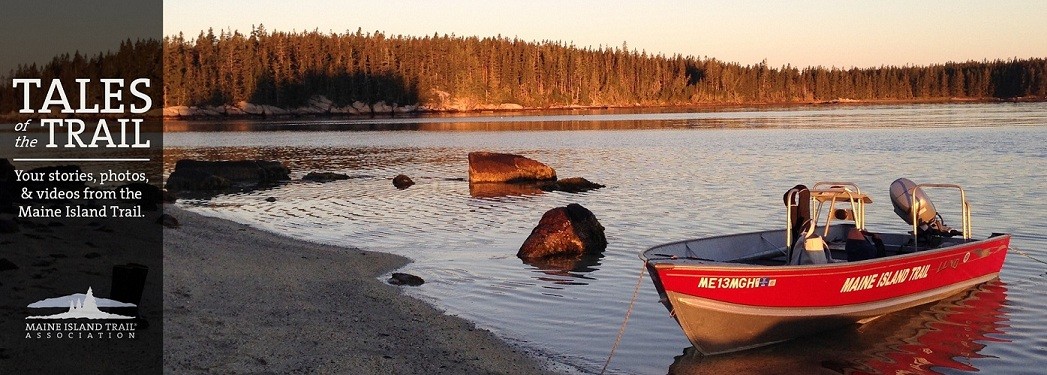Our Tales of the Trail blog is moving to www.mita.org/blog. Follow us there for more fun stories of Maine Island Trail adventures!
Tackling the Bold Coast and Cobscook Bay
MITA member Gary York, also a member of the North Shore Paddlers Network, recently shared with us his trip report from a serious paddler’s pilgrimage – downeast to the Bold Coast and Cobscook Bay. At the end of the Maine Island Trail, along the Canadian border, the Cobscook region is famous for its strong currents, remote shoreline, dense fog, cold water – and stark beauty. To learn about the hazards of Cobscook, click here.
In preparing for the trip, Gary and his companion assessed their paddling skills realistically, did research on the area and its tides and currents, waited for a good weather window, and sought advice from locals. The result – a unique and beautiful adventure! Click here to check out the detailed report, with plenty of practical advice. Thanks for sharing, Gary!
MITA’s Best of 2016
2016 was a bang-up year for MITA. From the smashing success of our first-ever fundraising party, Splash!, to two huge cleanup seasons (with more trash removed from the islands than ever before in MITA’s history!) we kept the momentum all year long. And as usual, we couldn’t do it without YOU – our volunteers, landowners, donors, partners, supporters, corporate sponsors, social-media-likers, friends and family. Thank you for everything you do for Maine’s wild islands – the coast of Maine wouldn’t be the same without the Trail. Here’s how 2016 shook out by the numbers:
-
Over 1,400 total stewardship visits were made to island and mainland Trail sites
-
Over 1,300 bags of trash were removed from island shorelines and over 400 buoys were returned to fisherman
-
Over 5,400 volunteer hours were spent on stewardship
We hope to see you out on the water in 2017!
Tales of the Trail Contest – Video Winner!
The video winner of our 2016 Tales of the Trail contest is new member Bob Stedman of Dover, NH. His combination live-action/slideshow account of a kayak trip to Stonington embodies the spirit of fun held by many Trail adventurers. Welcome to MITA, Bob!
Curious about the song? “It’s In The Way That You Use It” by Eric Clapton!
Tales of the Trail Contest – Story Winner!
We’re proud to announce the story winner of this year’s Tales of the Trail contest – MITA member James Li! We loved his beautiful tale of a tough little dinghy so much that we’re posting it here in its entirety, as well as publishing an abridged version in our Winter 2016 print newsletter. Thanks so much for your submission, James!
Check our Facebook page to see the winner of the photo contest, and stay tuned for another post later this week introducing our video winner. And now, without further ado:
STORY FOR A SMALL BOAT
by James Li
We’ve been long-time MITA members and for the past 15 years have had the unique opportunity to live year round on one of the smaller spruce-and-ledge islands in Muscongus Bay. We heat with the softwood we cut on island and use renewable energy to power our home.
Island living requires a lot of boat maintenance, particularly since we keep our boats in the water through the winter. Over the years, we’ve come to depend on a small hybrid rigid inflatable dinghy made by Walker Bay. Built from a virtually indestructible plastic polymer, the additional inflatable side tubes make it extremely stable and unsinkable. Because of these features, it serves as both our primary tender and safety boat.
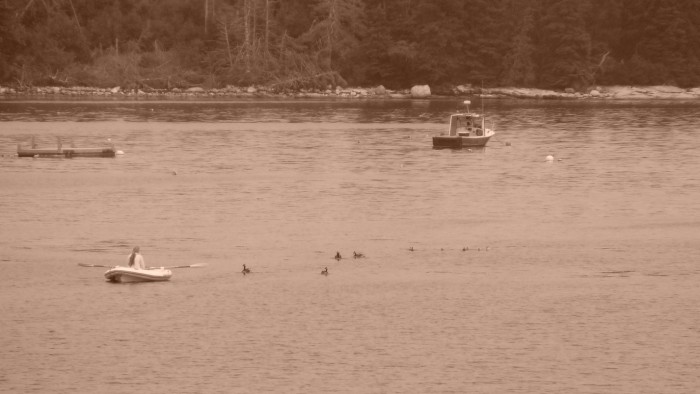
Walker Bay dinghy as lobster boat tender
The dinghy also is popular with local wildlife. Several winters ago, a local used it as a fishing base.

Hello there!
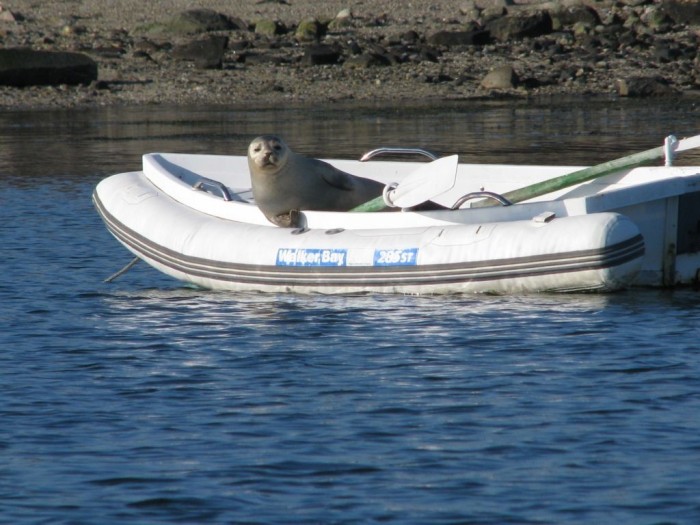
Walker Bay dingy as fishing command post
The Walker Bay was a spontaneous purchase in late fall many years ago. After experiencing a few close calls and one sinking incident with other skiffs, we found it on the season end sale rack outside the Rockland Hamilton Marine. It fit in the back of our pickup and came home with us that night. The dinghy proved its mettle the first winter it shared with us and continued to serve us through the years and winters that followed.
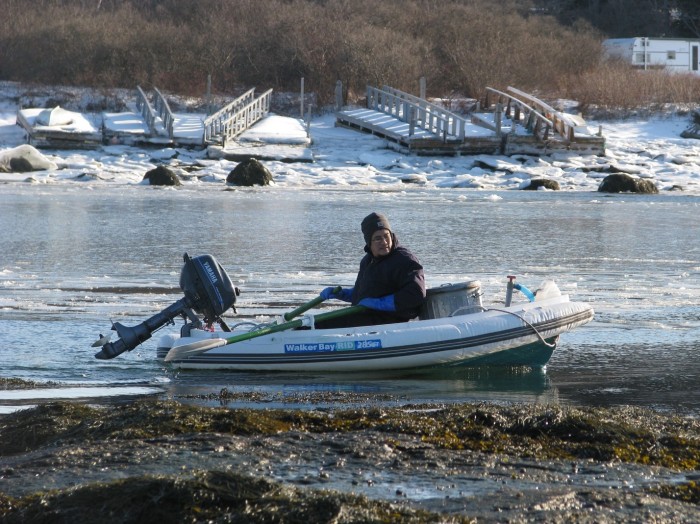
Winter use with oars or motor
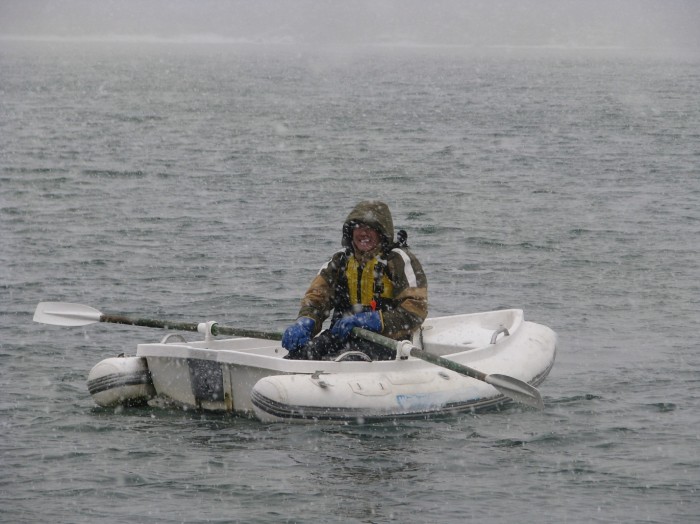
Rowing out to the lobster boat
Then came the freeze up of February 2015. I had to go ashore for work. A combination of calm and cold caused a significant buildup of sea ice in Muscongus Bay. The ice blocked passage for the lobster boat so I left home in a small 17-foot outboard, threading a passage around the islands to Friendship Harbor. Given the conditions, I wore a dry suit and carried a kayak as a backup.
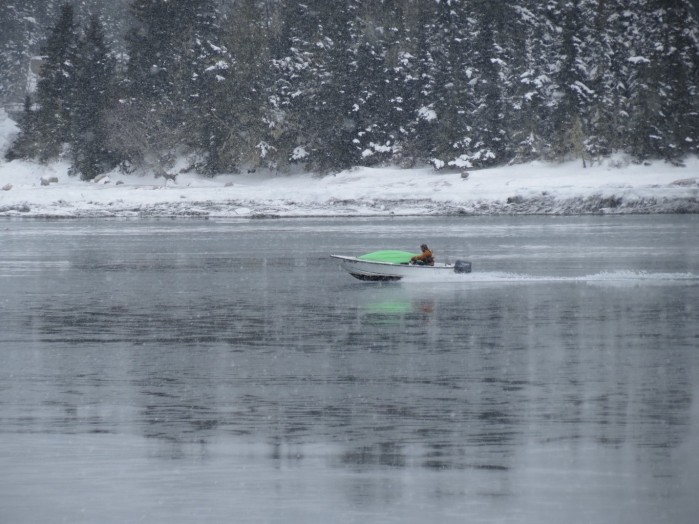
Leaving for work
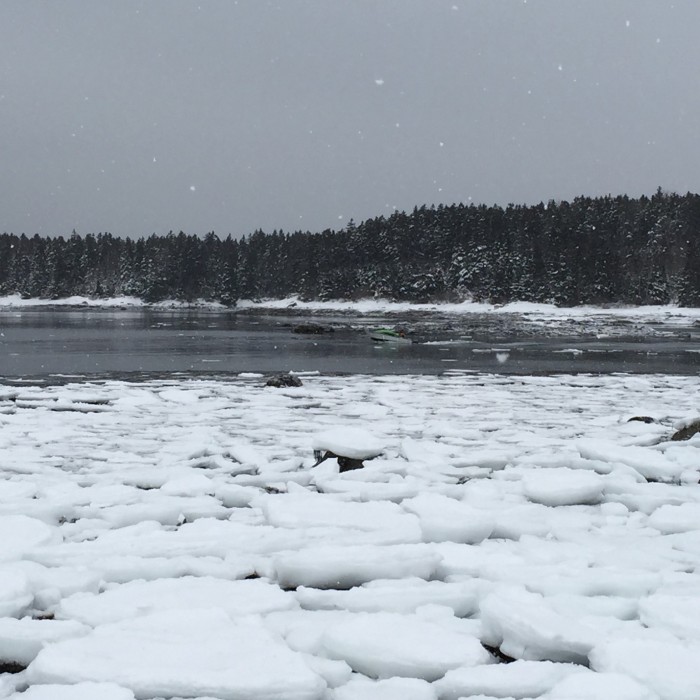
Through the ice
Within a few hours of making it to shore, the ice pack solidified and Friendship Harbor was rendered unusable to further boat traffic. Over the next month, the harbor ice remained solid enough for fishermen to walk out to their boats.
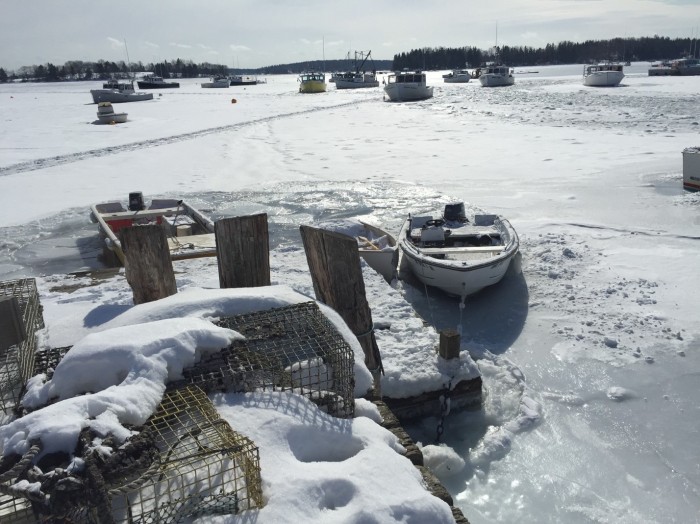
Outboard encased in 8 inches of solid sea ice – foot traffic evident to the Friendship lobster boat fleet
Combined with the cold calm air, nearly daily snowfall buried our home. Indeed, the woodpiles that we had stacked six feet high were buried under two feet of snow. To bring wood to the house required snowshoes, a sled, and a shovel.
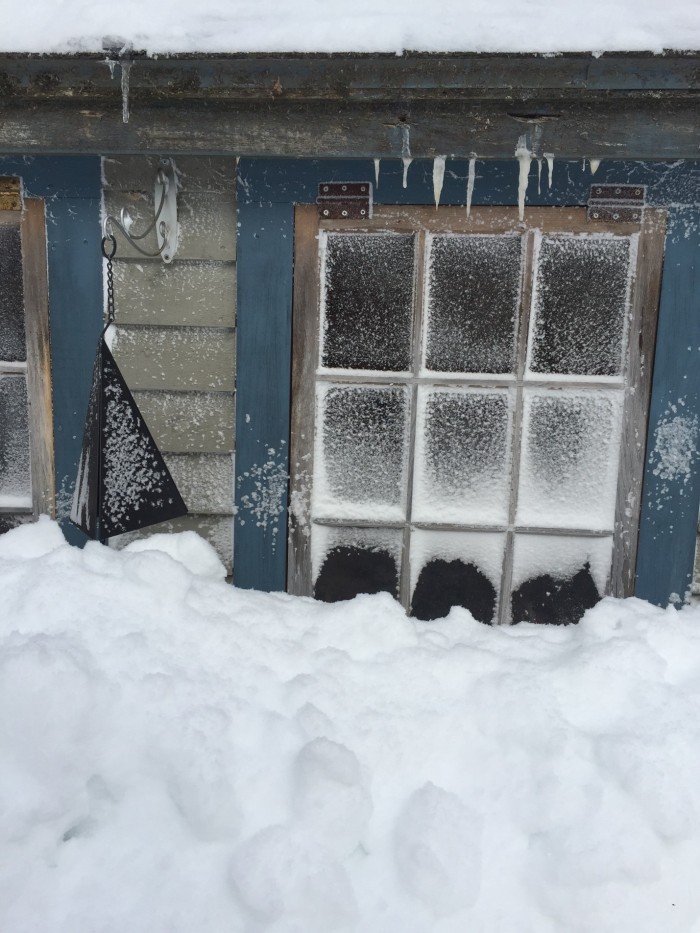
Snowdrifts cover our windows
Most importantly, sea ice made Muscongus Bay impassable for the next month. I was stuck on shore while my wife spent her days tending the fires, animals, and off-grid systems at home.
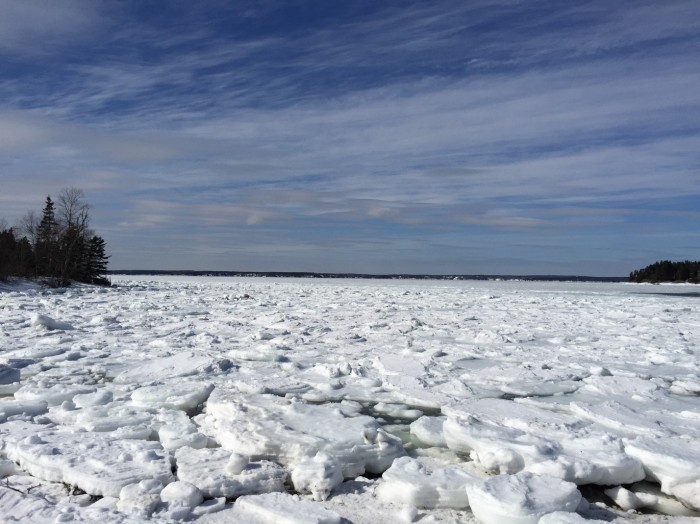
The view west across Muscongus Bay, February 2015
Sometime during the early morning hours of February 13 — our anniversary, no less — my wife called me at work to tell me that the large ice pack encasing the Walker Bay dinghy had broken up and was being pushed east in moderate winds. Despite her attempts to keep it clear, the dinghy had become completely icebound and the ice pack had torn it loose from its mooring line. She recorded its progress as it disappeared eastward, trapped in a large ice floe.
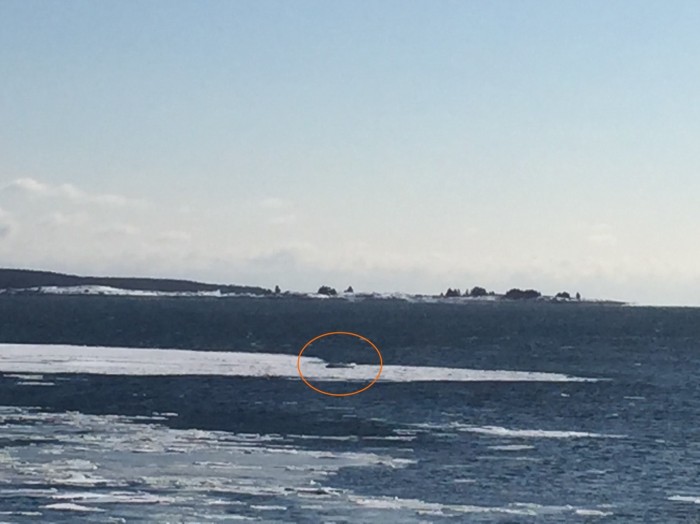
Last view of the Walker Bay dinghy, encased in an ice floe (Port Clyde is in the distance)
Here, our story diverges, for the tale is actually not about us but the Walker Bay dinghy.
(For interested readers, ten days after reporting the loss of the dinghy, my wife called to let me know our lobster boat had also been carried off her mooring by a second large ice pack. Not being able to bear the loss of another boat, she donned a dry suit, life vest, VHF radio, and head cam, and kayaked out in pursuit, rescuing it later that day. I made it home in March when the ice broke up.)
Over the next season, we searched Muscongus Bay for the lost dinghy and notified local harbormasters to keep an eye out. After months without news, we figured it had probably drifted into the Atlantic, permanently lost.
Then in August, we received a message from the Hog Island Audubon camp: “At the local MITA stewardship picnic earlier this week, there was discussion of July’s beach cleanup and they mentioned a dinghy washed up on Bar Island south of Louds this spring. It sounded like your type of dinghy and they said they would send photos of it. Apparently it was pretty beat up with a large hole.”
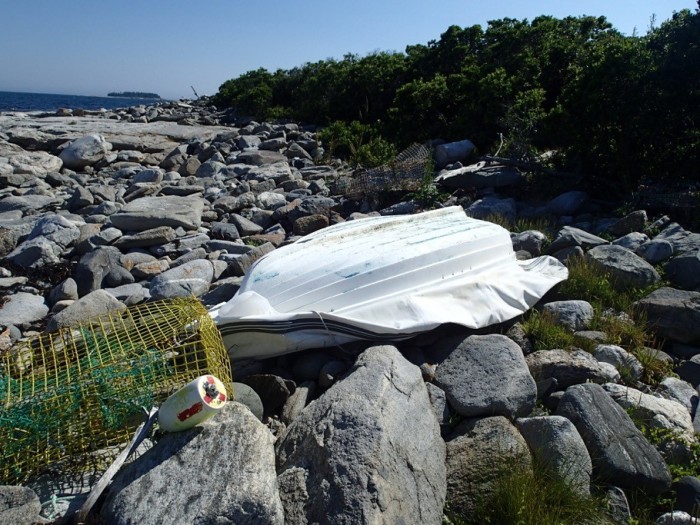
Our baby is found on Bar Island!
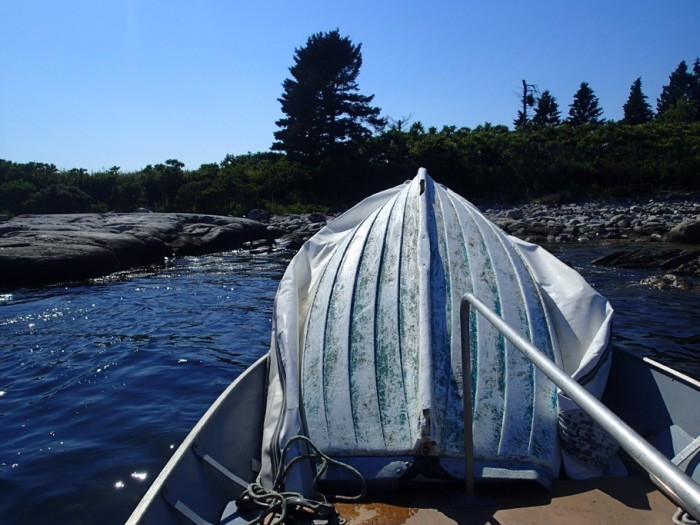
Several hull breaches are evident as it is taken ashore, headed to the dump
Eventually, we learned that Brian Marcaurelle, MITA’s program director, had rescued our Walker Bay from its intended landfill run and was planning on turning it into a backyard sandbox for his young son. Brian generously offered to bring it back to the midcoast when he next visited. The handoff happened in October and our worn unhappy dinghy returned home, where it went into our barn for winter repairs.
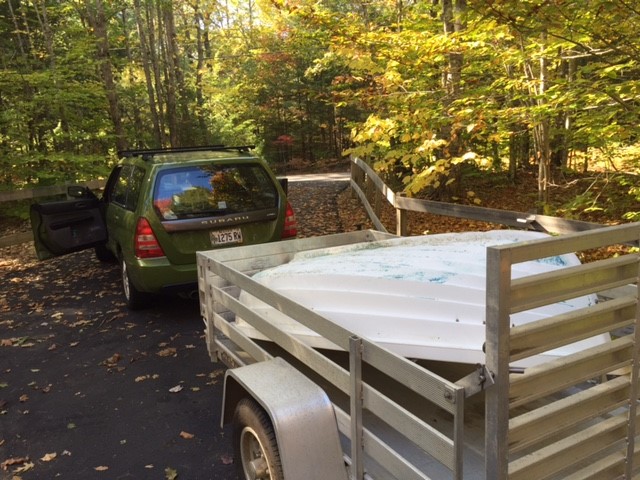
The handoff
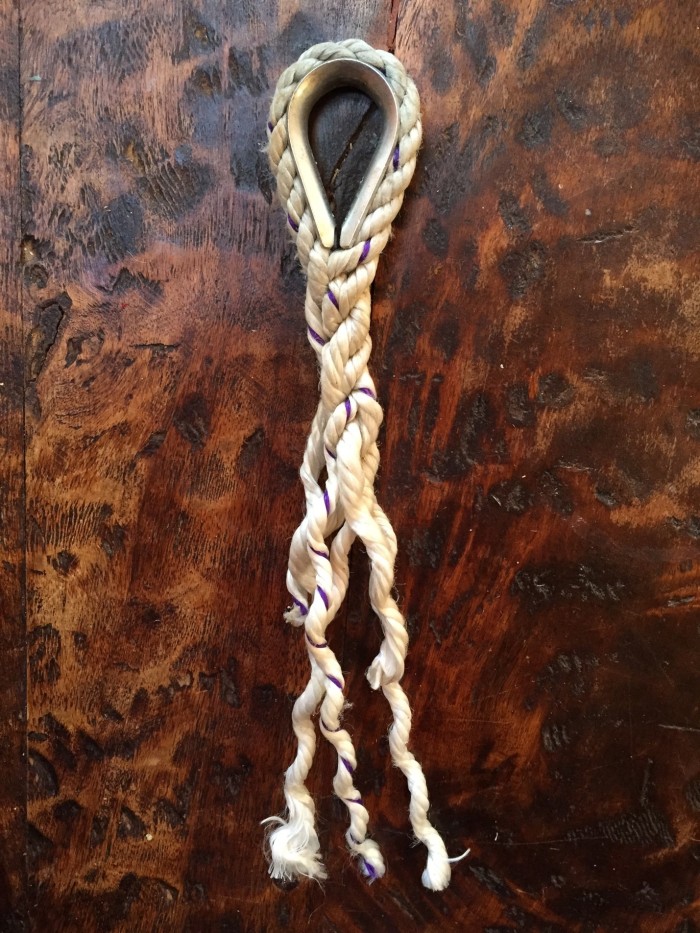
The painter, where it had separated from the mooring due to the pull of the ice
Several large holes in the hull lined the short keel where it had been repeatedly ground by Bar Island’s ledge and beach rocks. Over the winter, I cleaned, scraped, and prepped the hull for repair. I contacted Walker Bay and was encouraged to attempt hull repairs using a specific fast-setting plastic epoxy. The recommended repair product turned out to be a two-part urethane/isocyanate compound that sets up in 90 seconds and is manufactured by Fusor for automotive applications. I used fiberglass cloth mesh to reinforce the repair and added a metal rub strake to the bottom as well.
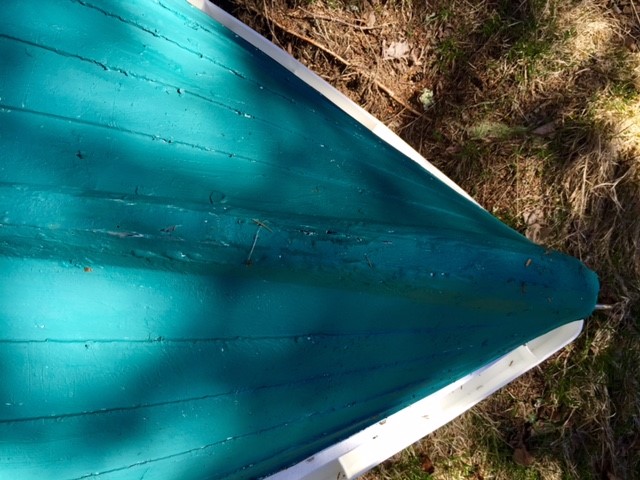
Bow hull after repairs and bottom paint
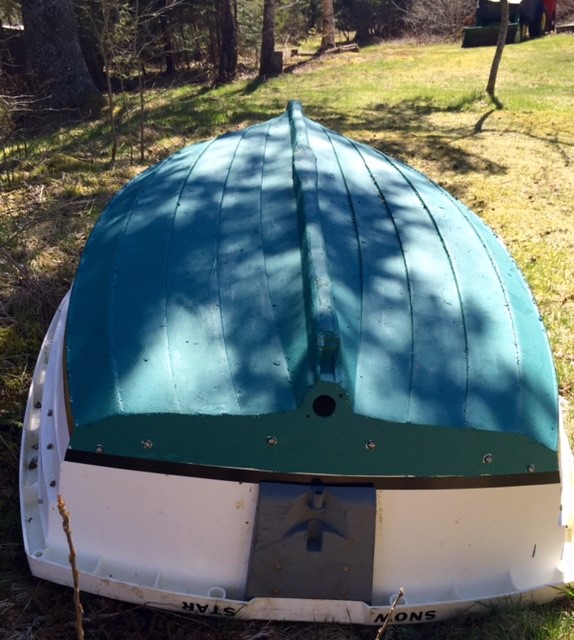
Almost ready
After the repairs, my wife and I rechristened the dinghy “Snow Star” and got her ready for relaunching.
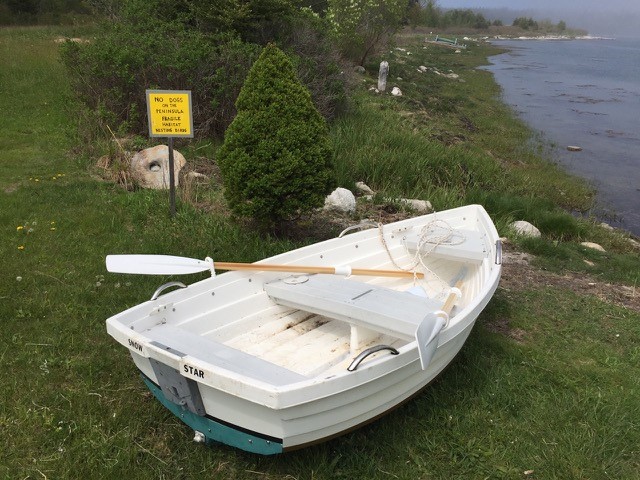
Re-launch day
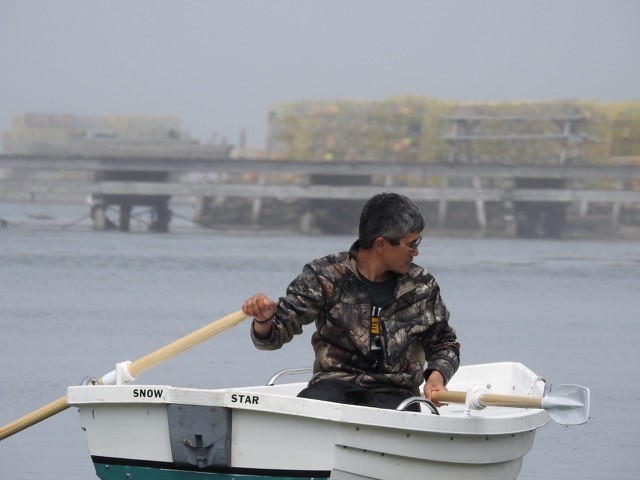
Back in the water!
Since she’s returned to the water, the Snow Star has proved worthy of her repairs. She’s lost her inflatable tubes but is just as nimble and agile as before.
Two months after her return to work, I brought her to Criehaven Island on the Tiny Barge. I was serving as navigator and mate on the 70-mile freight run. She served as our tender.
A heartfelt thank you goes to the Muscongus Bay MITA cleanup crew of 2015 as well as the MITA officers who lugged the Snow Star all over the state for us.
She’s our serious little dinghy.
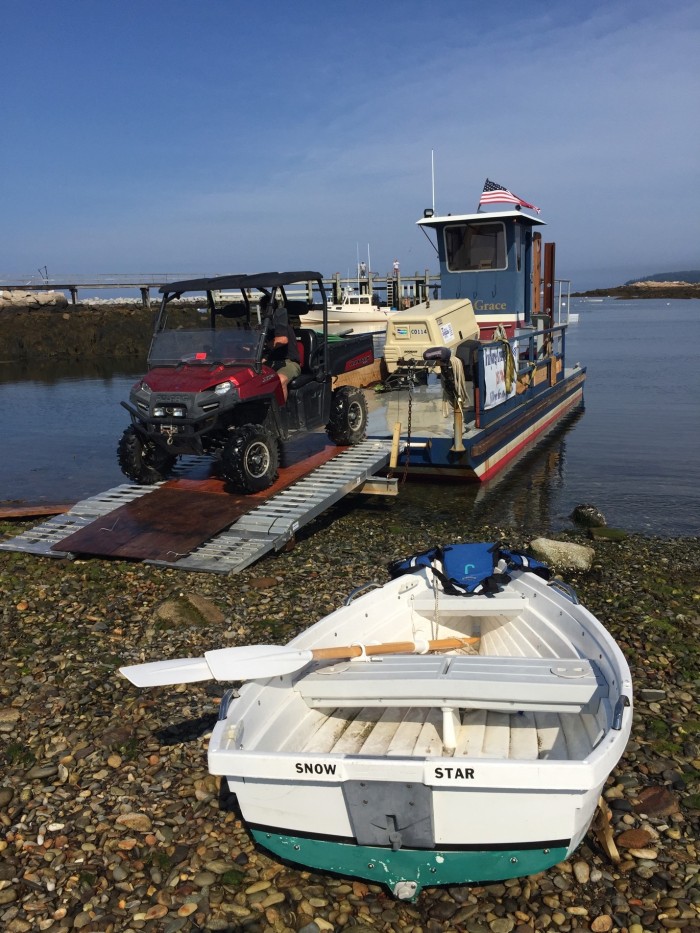
And back to working hard
Good Times on Merchant Row
The Merchant Row area, off of Stonington, is a world-renowned sea kayak destination – so we get many Tales of the Trail submissions describing adventures in the region! But we never get tired of reading them, because each boater who spends time on the Trail brings their own unique experience and perspective. Steve Priest, MITA member since 2008, submitted a detailed report and video last year from his personal blog: check it out here for practical Trail trips and a fun focus on camaraderie and new experiences!
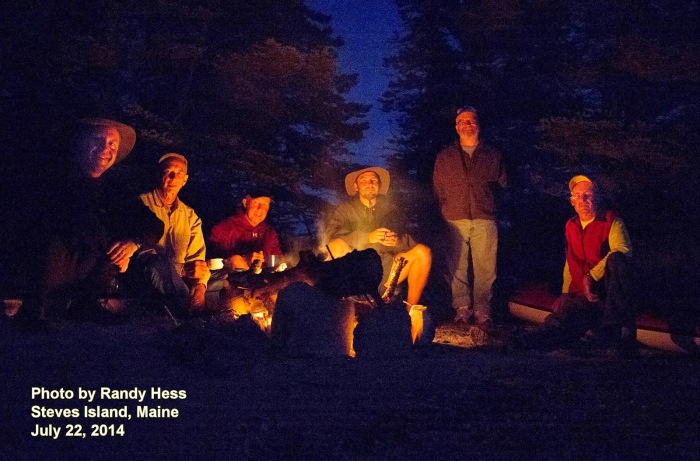
MITA on TV!
Filmed as part of a Canadian TV series by the Smithsonian Channel Canada called “America Over The Edge,” this 2015 segment features the Maine Island Trail!!
Check out MITA Executive Director Doug Welch’s moment in the spotlight, and enjoy the beautiful aerial footage of Casco Bay:
2016 Volunteer Recognition Awards
Every August, at our annual Stewardship Party, we recognize volunteers who have gone above and beyond to help MITA in its mission of protecting and stewarding the wild islands of Maine. This year’s party, in Belfast for the first time, was a great way to celebrate the thousands of hours volunteers put into the Trail every boating season! The 2016 award winners are:
Spirit of Stewardship: Ben Fuller
Spirit of Stewardship: Lynn Jenness & Don Hendrich
Spirit of the Trail: Dan Carr
Spirit of Partnership: Chimani
Margaret C Emerson Spirit of Giving: East Coast Yacht Sales
Dave & Dorrie Getchell Spirit of MITA: Rodger Herrigel
Learn more about them below:

Rodger Herrigel (right) receives the Spirit of MITA award from Dave Getchell Sr (left) and Doug Welch
Ben Fuller – Spirit of Stewardship: Ben has been a stewardship volunteer since the early days of the Trail. He logs many hours each season, both at the tiller and representing MITA at outreach events. His help maintaining the fleet, as well as his positive attitude and willingness to step up, make him invaluable.
Lynn Jenness & Don Hendrich – Spirit of Stewardship: This team of volunteers is willing to travel anywhere along the coast. They’ve assisted with cleanups and work days, towed MITA skiffs, used their own boat for MITA projects, opened their home to MITA volunteers and staff…and they are perhaps best known for their role taking care of the next generation of island stewards!
Dan Carr – Spirit of the Trail: Dan’s dedication to the coast and his love of paddling are unparalleled. He has been a board member since 2012, and is an active member on several committees. He led the charge in the recent fundraising effort for Ram Island, and is always out in his kayak scouting new Trail sites, most recently along the Bold Coast.
Chimani – Spirit of Partnership: The talent behind MITA’s popular mobile app, Chimani has given many hours of development, troubleshooting, and updating to the digital version of our ever-popular Trail Guide. Due to their hard work and generosity, the app gets more user-friendly, more functional, and more beautiful every year.
East Coast Yacht Sales – Spirit of Giving: Jon & Cindy Knowles, owners of ECYS, are both active MITA volunteers, with Cindy as a long-time board and committee member. Their donation of the ECYS warehouse/sales floor as venue for our Splash! event helped make it a party for the ages. Scott Woodruff of ECYS has also been endlessly helpful as a broker for our larger boat donations.
Rodger Herrigel – Dave and Dorrie Getchell Spirit of MITA: Rodger has been a MITA board and committee member since 2007! His giving truly knows no bounds – whether it’s financial resources, vehicles, gift memberships, or positive attitude and good ideas at committee meetings. He brings a unique personal touch to everything he does at MITA, and we hope to maintain his spirit of fun even after he moves on from board service at the end of this year.
MITA and Microplastics
The Maine Island Trail Association’s annual island cleanups certainly help keep Trail sites looking good – but that’s not the primary reason we do what we do!
Even more importantly, marine debris – especially plastics – in our ocean cause myriad environmental problems. Since this debris doesn’t biodegrade, it simply breaks down into smaller and smaller pieces, which are near impossible to remove and harmful to all kinds of marine life. In a recent blog post, MITA cleanup volunteer Peter Jones ruminates on marine debris, how it travels across the ocean, and why it’s so important to “Leave No Trace.”
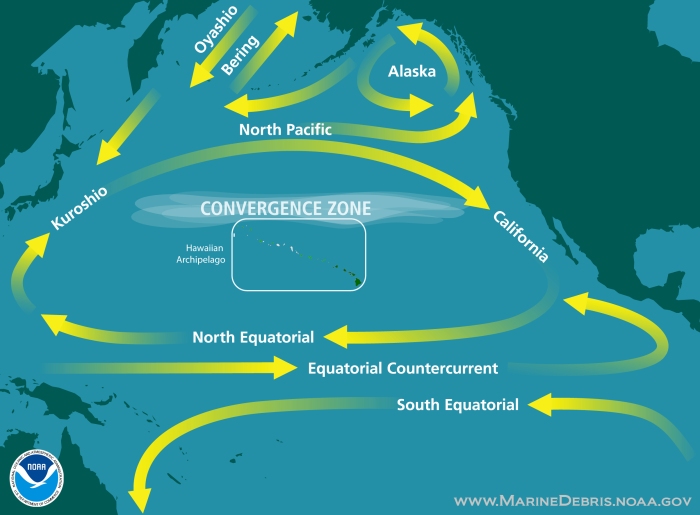
Cold Blood, Hot Sea: Intrigue on the Ocean!
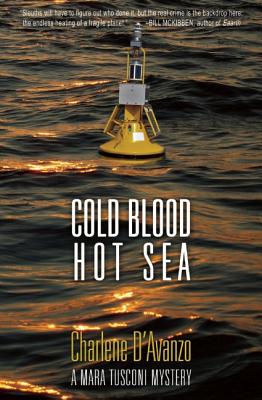 Mystery writer Charlene D’Avanzo releases her new novel Cold Blood, Hot Sea this month. It’s an exciting tale of environmental mystery, in which oceanographer Mara Tusconi is forced to confront the world of anti-climate-change big energy conspirators with both her research and her life on the line. Charlene lives in Maine and is a long-time paddler and MITA member – she even mentions MITA in her book! We recently had the chance to chat with her about climate fiction and the Maine Island Trail.
Mystery writer Charlene D’Avanzo releases her new novel Cold Blood, Hot Sea this month. It’s an exciting tale of environmental mystery, in which oceanographer Mara Tusconi is forced to confront the world of anti-climate-change big energy conspirators with both her research and her life on the line. Charlene lives in Maine and is a long-time paddler and MITA member – she even mentions MITA in her book! We recently had the chance to chat with her about climate fiction and the Maine Island Trail.
What is the basic premise of Cold Blood, Hot Sea?
I was motivated to write Cold Blood, Hot Sea after listening to a famous climate scientist describe the harassment he had to endure at the hands of climate change deniers. I was horrified that the very people trying to figure out this extraordinarily complex global human-caused phenomenon were being hounded in this way. The idea to write a novel with this underlying theme came to me because other scientists just weren’t reaching the public via the usual means. I chose mysteries because I read a ton of them, and the idea of the protagonist solving a puzzle works well with a scientist as lead character. My goal was to write an engaging, face-paced story through which readers would gain a better understanding of impacts of warming in Maine’s coastal waters – without being preachy at all. Many people have little idea what scientists actually do day-to-day, so that was also a goal.
How does the Maine Island Trail figure into the book?
My protagonist, Mara Tusconi, is an oceanographer and avid sea kayaker. On several occasions she paddles out to islands off the fictitious town of Spruce Harbor. I specifically mention MITA at a crucial moment. Mara and her colleague Ted McKnight (he’s the love interest) paddle out to “Cove Island” on a lovely spring day. Mara is secretly terrified of giving speeches to the public (her reasons are explained via the story). Ted is trying to convince her to be the spokesperson for climate researchers at a big-deal meeting in a few weeks. Before they get to the island and discuss this turning point in the story, Mara asks Ted if he’s a MITA member. When he hesitates, she tells him to “get with the program because the Maine Island Trail Association protects hundreds of Maine islands.” She threatens to “come after you” if he doesn’t. Ted laughes and adds, “I’m sure you will.” It’s a light moment before things get heavy.
What are some of your own experiences on the Maine Island Trail? How did those experiences shape you as a writer?
The first time I visited a MITA island was probably twenty years ago when Lee Bumsted (LL Bean guide, MITA member forever) took me to a few islands off Stonington. I was astonished that these precious bits of land off the coast were available to boaters to land on, walk around, and even camp on. When I learned the number of MITA islands, I was flabbergasted and so very grateful. I’m part of a large group of paddlers who go to Stonington for a week of paddling in June. We’ve been doing it so long I can hardly remember a June when I haven’t revisted those MITA islands. My books are set on and right off the Maine coast. These are “environmental mysteries” because there is an environmental theme, but I think of the actual physical setting as a kind of character. I try to make the Maine coast come alive for people who have never been here and those who know it really well. You do that with imagery – visual, of course, but also smell, sound, touch. When I circle the islands and walk through them, I close my eyes and try to drink it all in so I can remember that later. For instance, a while back I stuck my hands into some boggy water in the middle of an island. It was much colder than I expected and deeper. I used that in a scene in which Mara must cross a soggy bog in a violent storm when she’s exhausted.
Is the Mara Tusconi character based on you? Is it easier for you to write about someone who’s similar to you, or very different?
As I explain on my website, Mara is like me in some ways but different in many others. We’re both marine scientists, although she’s an oceanographer and I studied the coast because I get terribly seasick. Mara shares that disastrous trait for an oceanographer. She’s much younger than I am – early 30’s. She’s pretty opinionated and sometimes rash, which I certainly was in my younger days. We’re both nuts about sea kayaking, although she’s much better at rolling her boat than I am. Mara’s famous scientist parents died in a submarine accident when she was 19, a tragedy that has shaped her. Her godfather Angelo is her only family. None of that happened to me, thank goodness.
What are some of the lessons you’d like readers to take away from the book that you think will resonate with MITA members?
In my experience, even folks with a strong environmental ethic have a difficult time grasping the climate change crisis – both the present-day impacts and what’s in store for our children and grandchildren. Given the scope of global warming, it’s understandably difficult for most of us to get a handle on what’s happening and what individuals can do about it. I would hope that Cold Blood, Hot Sea might stimulate readers to learn a little more so they can educate others, for instance. On my website, I include websites that provide good information plus books I’ve found helpful.
Interested in reading more? Purchase Charlene’s book here.
